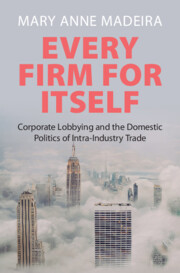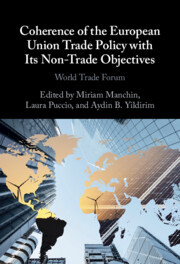Refine search
Actions for selected content:
59 results
Global Trends in Digital Trade Policies and Practices: Evidence from the Digital Trade Integration Database
-
- Journal:
- World Trade Review , First View
- Published online by Cambridge University Press:
- 13 November 2025, pp. 1-25
-
- Article
-
- You have access
- Open access
- HTML
- Export citation
A comparative review of Australia’s fashion and textile industry and global climate perspectives across five decades (1970s–2020s)
-
- Journal:
- Global Sustainability / Volume 8 / 2025
- Published online by Cambridge University Press:
- 08 October 2025, e41
-
- Article
-
- You have access
- Open access
- HTML
- Export citation
The Likely Micro- and Macro-Economic Consequences of a Unilateral US Trade Policy
-
- Journal:
- World Trade Review / Volume 24 / Issue 4 / October 2025
- Published online by Cambridge University Press:
- 12 September 2025, pp. 446-462
- Print publication:
- October 2025
-
- Article
-
- You have access
- Open access
- HTML
- Export citation
7 - The Politics of TPP and TTIP in the United States
-
- Book:
- Every Firm for Itself
- Published online:
- 21 July 2025
- Print publication:
- 07 August 2025, pp 139-169
-
- Chapter
- Export citation
3 - The Domestic Politics of Intra-Industry Trade: A Theoretical Model
-
- Book:
- Every Firm for Itself
- Published online:
- 21 July 2025
- Print publication:
- 07 August 2025, pp 40-59
-
- Chapter
- Export citation
8 - Conclusion
-
- Book:
- Every Firm for Itself
- Published online:
- 21 July 2025
- Print publication:
- 07 August 2025, pp 170-180
-
- Chapter
- Export citation
5 - Lobbying over Trade Policy in the European Union
-
- Book:
- Every Firm for Itself
- Published online:
- 21 July 2025
- Print publication:
- 07 August 2025, pp 87-115
-
- Chapter
- Export citation
Supplying Influence: Domestic Production Networks in Trade Politics
-
- Journal:
- International Organization / Volume 79 / Issue 3 / Summer 2025
- Published online by Cambridge University Press:
- 19 August 2025, pp. 456-493
- Print publication:
- Summer 2025
-
- Article
-
- You have access
- Open access
- HTML
- Export citation

Every Firm for Itself
- Corporate Lobbying and the Domestic Politics of Intra-Industry Trade
-
- Published online:
- 21 July 2025
- Print publication:
- 07 August 2025
8 - How Preferential Trade Agreements Are Perceived in Chile: From Love to Hate in a Single Step?
-
-
- Book:
- Globalization in Latin America
- Published online:
- 09 June 2025
- Print publication:
- 26 June 2025, pp 150-177
-
- Chapter
-
- You have access
- Open access
- HTML
- Export citation
Flexilateralism in EU Trade Policy: The Case of Aviation Fuels in the Hardening Environmental Trade Instruments
-
- Journal:
- Transnational Environmental Law / Volume 14 / Issue 2 / July 2025
- Published online by Cambridge University Press:
- 19 February 2025, pp. 420-452
-
- Article
-
- You have access
- Open access
- HTML
- Export citation
Congressional position-taking on punitive tariffs: president Trump’s 2018 auto tariff
-
- Journal:
- Business and Politics / Volume 27 / Issue 3 / September 2025
- Published online by Cambridge University Press:
- 30 January 2025, pp. 331-349
-
- Article
-
- You have access
- Open access
- HTML
- Export citation
Alienated Twins – The Overlooked Private Law Dimension of Global Trade and Investment Governance
-
- Journal:
- World Trade Review / Volume 23 / Issue 4 / October 2024
- Published online by Cambridge University Press:
- 14 May 2024, pp. 507-518
- Print publication:
- October 2024
-
- Article
-
- You have access
- Open access
- HTML
- Export citation
24 - Iberian Globalization and Catching Up in the Poor South European Periphery, 1830–2010
- from Part III - Industrialization and Catching Up, 1800–2000
-
-
- Book:
- An Economic History of the Iberian Peninsula, 700–2000
- Published online:
- 22 February 2024
- Print publication:
- 29 February 2024, pp 617-647
-
- Chapter
- Export citation
4 - Kicking Off the Miracle
-
- Book:
- The Tortuous Path of South Korean Economic Development
- Published online:
- 07 December 2023
- Print publication:
- 21 December 2023, pp 83-121
-
- Chapter
- Export citation
7 - EU Trade Agreements and Non-Trade Policy Objectives
-
-
- Book:
- Coherence of the European Union Trade Policy with Its Non-Trade Objectives
- Published online:
- 19 October 2023
- Print publication:
- 02 November 2023, pp 180-207
-
- Chapter
- Export citation

Coherence of the European Union Trade Policy with Its Non-Trade Objectives
- World Trade Forum
-
- Published online:
- 19 October 2023
- Print publication:
- 02 November 2023
5 - Women in the LDCs
- from Part II - Current Issues in Gender Equality and Trade Policies
-
-
- Book:
- Trade Policy and Gender Equality
- Published online:
- 05 October 2023
- Print publication:
- 19 October 2023, pp 97-119
-
- Chapter
-
- You have access
- Open access
- HTML
- Export citation
15 - The Post-Accession Treatment of Chinese Goods Exports by WTO Members
- from Part IV - Responses of China’s Trading Partners
-
-
- Book:
- China and the WTO
- Published online:
- 14 September 2023
- Print publication:
- 28 September 2023, pp 360-380
-
- Chapter
-
- You have access
- Open access
- HTML
- Export citation
Trade and Sustainable Development: Non-Economic Objectives in the Theory of Economic Policy
-
- Journal:
- World Trade Review / Volume 22 / Issue 3-4 / October 2023
- Published online by Cambridge University Press:
- 05 September 2023, pp. 463-473
- Print publication:
- October 2023
-
- Article
-
- You have access
- Open access
- HTML
- Export citation
